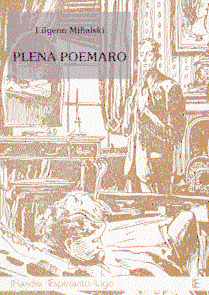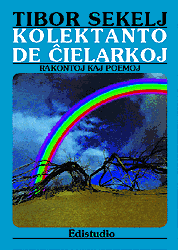Five Periods of Esperanto Literature Posted by Chuck Smith on Feb 25, 2011 in Literature, Uncategorized
When I lived in Rotterdam, I remember taking the trip to visit the Internacia Esperanto-Instituto for an Esperanto literature seminar. It was most helpful for recognizing important authors, but when I think back on that seminar, I remember being impressed by how Esperanto literature can be divided into different periods based on different styles of writing. I also remember sitting in offices of the Universal Esperanto Association and reading the Fundamenta Krestomatio and being amazed at how the style of the language felt so old… in a planned language, incredible! Now, I’ll let Amelie Ambrus show you how the Concise Encyclopedia divides Esperanto literature into periods. Also, see her first post about an Introduction to Esperanto Literature.
This article is a quick sketch of the literary periods of original Esperanto literature, as presented by Geoffrey Sutton’s Concise Encyclopedia of the Original Literature of Esperanto, reviewed previously on this blog. More information on individual authors will follow in later articles. All quotes are from the Concise Encyclopedia.
The First Period: 1887-1920. Primitive Romanticism and the Establishment of Style

In the first period, Lejzer Ludwik Zamenhof, the initiator of Esperanto, was particularly influential; however, he prioritized translation and rarely wrote original literature. The Concise Encyclopedia, focusing on original literature, says “the period’s most influential writer of prose was undoubtedly Kaziemierz Bein” and “the first generation’s leaders were the five writers: Antoni Grabowski, V. N. Devjatnin, Leo Belmont, Abram Kofman, and Felix Zamenhof“. Nonetheless, most of the writing of that period tends to feel a little old-fashioned now, sort of like reading English from the 1700s and 1800s. It’s easier than Shakespeare, and perhaps comparable to Dickens, in how far away it seems from modern language use. The second period onward tend to have authors who seem more contemporary; the rest of this article deals with those.
The Second Period: 1921-1930. Mature Romanticism and a Literary Flowering
The second period is exemplified by the original writing of Kálmán Kalocsay and Julio Baghy, of the Budapest School. “Kalocsay was to dominate the following decades of poetry. His influence up to and beyond the 1950s cannot be overestimated. Mondo kaj Koro [A World and a Heart] was later to be seen as inaugurating the Second Period of Esperanto literature. His second collection, Streĉita Kordo [Stretched String], was to inaugurate the Third”. Both authors were also very influential on prose styles. Eŭgeno Miĥalski also hails from this time; his poetry is sometimes judged superior even to Kalocsay’s; his highly experimental, yet highly readable, style merits serious attention. Also notably, Esperanto had already expanded beyond Europe. “Of the first generation of Japanese writers, two outstanding original poets continued working into the second generation: (Kenĵi) Ossaka and (Saburô) Itô“, publishing collections of poems as early as 1921. Other Japanese writers in Esperanto at this time were Masao Nisimura, Kisaku Tabata, and Koĵiro Nakagaki. Parody also started to appear; Raymond Schwartz is well-known for his humor, including lovingly lampooning excesses of the Esperanto community.
The Third Period: 1931-1951. Parnassianism and the Coming of Age
The third period contains many of the same authors as the second. It was also marred by tragedy, as many of the best Esperanto authors were systematically killed, and Esperanto was made illegal in several countries under various communist and fascist regimes. It was also filled with critiques of these regimes; Vladimir Valentinovič Varankin critiqued Stalinist Russia in Metropoliteno [Subway], Austrian Hans Weinhengst (a.k.a Johan Weinhengst) wrote the socially critical Tur-strato 4 [4 Tower Street], while Teru Hasegawa (a.k.a. Verda Majo) opposed Japanese military expansion. She spent time protesting it in occupied China, writing about it in Flustr’ el Uragano [Whisper out of a Hurricane]. Neither Varankin nor Weinhengst survived; Miĥalski was also among the many who perished.
The Fourth Period: 1952-1974. Post-Parnassianism and Modernism

In the fourth period, stories by Tibor Sekelj took the world by storm. The Scottish School also appeared, and William Auld wrote the epic poem La Infana Raso [The Child Race]. He was nominated three times for a Nobel prize in literature. Marjorie Boulton, the foremost female Esperanto poet, wrote Kontralte [In Contralto], published in 1955. Albert Goodheir wrote a poetry collection, Merlo sur Menhiro [Blackbird on a Menhir], and he has been compared to Wordsworth. A South African, Edwin de Kock, not content with his mastery of Xhosa, Afrikaans, and English, learned Esperanto. He soon published Ombroj de la Kvara Dimensio [Shadows of the Fourth Dimension]. His poetic style is highly controversial, clashing with Kalocsay’s theories, but he is often considered one of Esperanto’s top poets. This period was rich in excellent Esperanto poets; his contemporary, Icelander Baldur Ragnarsson, of Ŝtupoj sen Nomo [Stairs with No Name] and Esploroj [Explorations], was nominated for a Nobel Prize in Literature in 2007.
The fourth period also had increased literary output from Asia, India, and Brazil. Bengali Lakshmiswar Sinha wrote Hindo Rigardas Svedlandon [An Indian Looks at Sweden] and Jaroj sur la Tero [Years on Earth]. Geraldo Mattos, writing in Esperanto from Brazil, mastered the Japanese tanka poetry style in Miniaturoj [Miniatures]; in Arĉoj [Bows], “the suggestiveness of his language seesaws on the brink of untranslatability”. Roberto Nogueira, also from Brazil, wrote the significant Vojo kaj Vorto [Way and Word], reacting against Kalocsay’s Parnassianism. Masao Ueyama and Masao Miyamoto contributed original prose and poetry, and translations from Japan. Unfortunately, persecution continued in some countries; Armond Su wrote Esperanto poetry, first published in 1960, but was jailed during China’s Cultural Revolution, and never fully recovered, dying young. The memory of persecution lingered in others; Masao Miyamoto wrote La Morta Suito [The Death Suite], about Sakae Ōsugi, a Japanese Esperanto speaker who was killed by the Japanese government, along with his family. On a lighter note, Gaku Konisi of Japan, a professor of theoretical physics, wrote La Kosmoŝipo ‘Edeno n-ro 5 [The Spaceship Eden No. 5], a collection of short science fiction stories.
The Fifth Period: 1975-. Popularization of the Novel, Experimental Poetry, Postmodernism
The fifth period, from 1975 onward, merits an article of its own. Both due to the quantity of published material, and to being recent and ongoing, it is quite difficult to summarize as concisely as the earlier periods. Nonetheless, some notable authors from this period include Jorge Camacho, Trevor Steele, Claude Piron, István Nemere, Sten Johansson, Serĝo Elgo (a.k.a. Georges Lagrange), Abel Montagut, Mauro Nervi, Nicolino Rossi, Karolo Piĉ, Eli Urbanová, Timothy Carr, Krys Ungar, Gafur Gazizi, Alen Kris, and Mao Zifu. Poetry collections with too many authors to name continue to appear; Moskvaj Sonoriloj [Moscow Bells] has 36 authors. Notable fourth-period authors such as Reto Rossetti, John Francis, Albert Goodheir, Baldur Ragnarsson and Geraldo Mattos continue(d) to write. Popular literature, including crime novels, is flourishing. The first full novel in Esperanto by a native Esperanto speaker, Karuseloj [Carousels] by Sara Larbar, was published in 1987. More African authors are starting to appear; Togo’s Gbeglo Koffi was the first published sub-Saharan author in Esperanto other than Edwin de Kock, and Benin’s Jean Codjo has started producing notable stories.
In genres from popular fiction to postmodern novels and every sort of poetry, Esperanto literature is flowering. Start exploring it – it’s worth it!

Build vocabulary, practice pronunciation, and more with Transparent Language Online. Available anytime, anywhere, on any device.
About the Author: Chuck Smith
I was born in the US, but Esperanto has led me all over the world. I started teaching myself Esperanto on a whim in 2001, not knowing how it would change my life. The timing couldn’t have been better; around that same time I discovered Wikipedia in it’s very early stages and launched the Esperanto version. When I decided to backpack through Europe, I found Esperanto speakers to host me. These connections led me to the Esperanto Youth Organization in Rotterdam, where I worked for a year, using Esperanto as my primary language. Though in recent years I’ve moved on to other endeavors like iOS development, I remain deeply engrained in the Esperanto community, and love keeping you informed of the latest news. The best thing that came from learning Esperanto has been the opportunity to connect with fellow speakers around the globe, so feel free to join in the conversation with a comment! I am now the founder and CTO of the social app Amikumu.




Comments:
palaman:
Kial oni ne traduku la tekston esperanten? Ĝi estas sufiĉe interesa por la parolantoj.